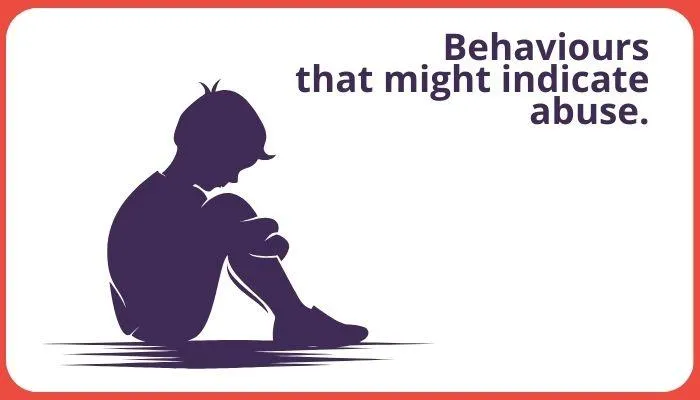Every child's well-being matters.
Types of Abuse Articles
Quick Access
Abuse of Authority
Abuse of Discretion
Abuse of Power
Behavioural Indications
Breast Ironing
County Lines
Cultural Differences (Physical Abuse)
Domestic Abuse
Economic Abuse
Emotional Signs
Exposure to Substance Abuse
Failure to Thrive
Female Genital Mutilation (FGM)
Forced Marriage
Hate Crimes & Targeted Harassment
Impact of Domestic Violence
Impact of Environment
Impact on Development
Institutional Abuse
Isolation
Modern Slavery
Neglect
Online Abuse
Parental Behaviours
Physical Abuse
Radicalisation
Religious Abuse
Restraint
Sexual Abuse
Types of Abuse
Witnessing Domestic Abuse

What behaviour might indicate a safeguarding issue?
Signs in a Child:
Sometimes, if a child often has injuries that are tough to explain, like bruises or cuts for strange reasons, it might be a warning sign.
A sudden and significant change in a child's behaviour, such as becoming unusually quiet, extremely angry, or overly obedient, could suggest an underlying issue that needs attention.
Children might show fear or actively avoid specific people or places. Understanding the reasons behind this behaviour is crucial for ensuring their safety.
Reverting to behaviours from earlier stages, like bedwetting or thumb-sucking, might indicate that the child is going through a tough time.
If a child is unusually secretive, especially about interactions with adults or other children, it could signal that they need help.
Signs in a Parent or Carer:
Regular displays of anger or aggression from someone responsible for a child's care are unacceptable. A child deserves a safe and nurturing environment.
Providing inconsistent or unconvincing explanations for a child's injuries or behavioural changes is cause for concern.
Avoiding friends or family might limit a parent or caregiver's access to support, potentially affecting the child's well-being.
If an individual responsible for a child is excessively using drugs or alcohol, it can impair their ability to care for the child properly.
Adults dealing with persistent sadness or anxiety may struggle to provide the necessary care and attention a child requires.
AUTHOR:- Iona has nearly 10 years of experience supporting nurseries and childminders in curriculum planning, leadership, and safeguarding. Her writing is informed by public information and sector insight, aiming to provide accessible, practical support for professionals working with children. She is part of the On the Button team, helping deliver Well-being, Safeguarding and Complaint Management Software that empowers practitioners to identify concerns early and act confidently.
On the Button provides innovative software tailored to the needs of the early years sector, with a strong focus on EYFS well-being and early years safeguarding. Our tools help senior practitioners to confidently track concerns, maintain robust records, and respond effectively — all while meeting statutory guidance. From early years complaint management to team-wide safeguarding alerts, our platform puts children's safety and emotional health first.
Quick Access
Abuse of Authority
Abuse of Discretion
Abuse of Power
Behavioural Indications
Breast Ironing
County Lines
Cultural Differences (Physical Abuse)
Domestic Abuse
Economic Abuse
Emotional Signs
Exposure to Substance Abuse
Failure to Thrive
Female Genital Mutilation (FGM)
Forced Marriage
Hate Crimes & Targeted Harassment
Impact of Domestic Violence
Impact of Environment
Impact on Development
Institutional Abuse
Isolation
Modern Slavery
Neglect
Online Abuse
Parental Behaviours
Physical Abuse
Radicalisation
Religious Abuse
Restraint
Sexual Abuse
Types of Abuse
Witnessing Domestic Abuse

What behaviour might indicate a safeguarding issue?
Signs in a Child:
Sometimes, if a child often has injuries that are tough to explain, like bruises or cuts for strange reasons, it might be a warning sign.
A sudden and significant change in a child's behaviour, such as becoming unusually quiet, extremely angry, or overly obedient, could suggest an underlying issue that needs attention.
Children might show fear or actively avoid specific people or places. Understanding the reasons behind this behaviour is crucial for ensuring their safety.
Reverting to behaviours from earlier stages, like bedwetting or thumb-sucking, might indicate that the child is going through a tough time.
If a child is unusually secretive, especially about interactions with adults or other children, it could signal that they need help.
Signs in a Parent or Carer:
Regular displays of anger or aggression from someone responsible for a child's care are unacceptable. A child deserves a safe and nurturing environment.
Providing inconsistent or unconvincing explanations for a child's injuries or behavioural changes is cause for concern.
Avoiding friends or family might limit a parent or caregiver's access to support, potentially affecting the child's well-being.
If an individual responsible for a child is excessively using drugs or alcohol, it can impair their ability to care for the child properly.
Adults dealing with persistent sadness or anxiety may struggle to provide the necessary care and attention a child requires.
AUTHOR:- Iona has nearly 10 years of experience supporting nurseries and childminders in curriculum planning, leadership, and safeguarding. Her writing is informed by public information and sector insight, aiming to provide accessible, practical support for professionals working with children. She is part of the On the Button team, helping deliver Well-being, Safeguarding and Complaint Management Software that empowers practitioners to identify concerns early and act confidently.
On the Button provides innovative software tailored to the needs of the early years sector, with a strong focus on EYFS well-being and early years safeguarding. Our tools help senior practitioners to confidently track concerns, maintain robust records, and respond effectively — all while meeting statutory guidance. From early years complaint management to team-wide safeguarding alerts, our platform puts children's safety and emotional health first.

What behaviour might indicate a safeguarding issue?
Signs in a Child:
Sometimes, if a child often has injuries that are tough to explain, like bruises or cuts for strange reasons, it might be a warning sign.
A sudden and significant change in a child's behaviour, such as becoming unusually quiet, extremely angry, or overly obedient, could suggest an underlying issue that needs attention.
Children might show fear or actively avoid specific people or places. Understanding the reasons behind this behaviour is crucial for ensuring their safety.
Reverting to behaviours from earlier stages, like bedwetting or thumb-sucking, might indicate that the child is going through a tough time.
If a child is unusually secretive, especially about interactions with adults or other children, it could signal that they need help.
Signs in a Parent or Carer:
Regular displays of anger or aggression from someone responsible for a child's care are unacceptable. A child deserves a safe and nurturing environment.
Providing inconsistent or unconvincing explanations for a child's injuries or behavioural changes is cause for concern.
Avoiding friends or family might limit a parent or caregiver's access to support, potentially affecting the child's well-being.
If an individual responsible for a child is excessively using drugs or alcohol, it can impair their ability to care for the child properly.
Adults dealing with persistent sadness or anxiety may struggle to provide the necessary care and attention a child requires.
AUTHOR:- Iona has nearly 10 years of experience supporting nurseries and childminders in curriculum planning, leadership, and safeguarding. Her writing is informed by public information and sector insight, aiming to provide accessible, practical support for professionals working with children. She is part of the On the Button team, helping deliver Well-being, Safeguarding and Complaint Management Software that empowers practitioners to identify concerns early and act confidently.
On the Button provides innovative software tailored to the needs of the early years sector, with a strong focus on EYFS well-being and early years safeguarding. Our tools help senior practitioners to confidently track concerns, maintain robust records, and respond effectively — all while meeting statutory guidance. From early years complaint management to team-wide safeguarding alerts, our platform puts children's safety and emotional health first.
Quality Early Years Ltd.,
Dickens House,
Guithavon Street,
Witham, Essex,
England, CM8 1BJ
© Quality Early Years Ltd 2025
On the Button are Finalists for 3/3 Early Years Awards!
Find On the Button
on Social Media

